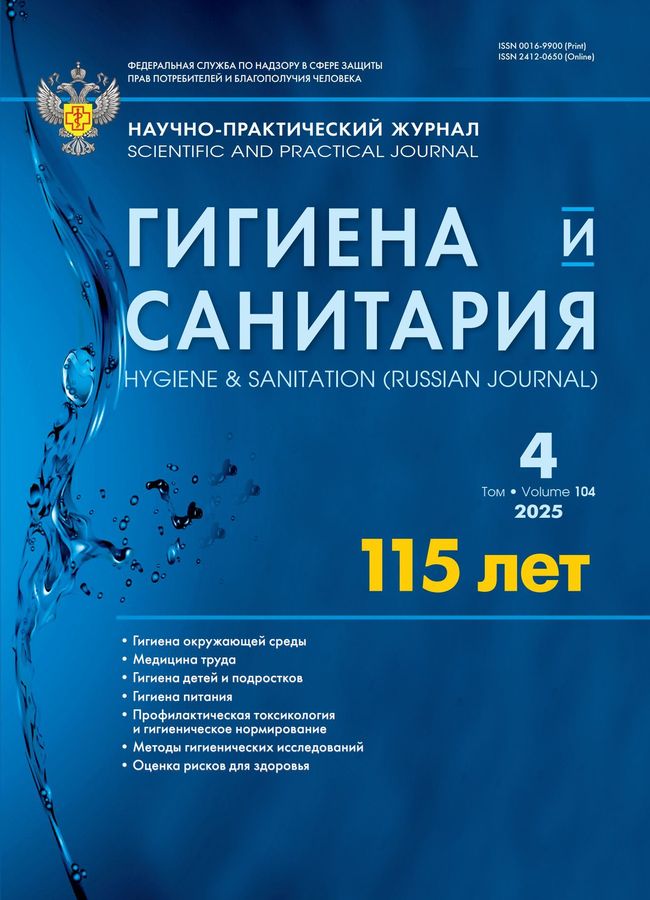Changes in elemental homeostasis and gene expression profile under subchronic hydroxide intoxication with aluminum
- Authors: Usmanova E.N.1, Karimov D.O.1, Daukaev R.A.1, Valova Y.V.1, Smolyankin D.A.1, Khusnutdinova N.Y.1, Karimov D.D.1, Adieva G.F.1
-
Affiliations:
- Ufa Research Institute of Occupational Health and Human Ecology
- Issue: Vol 104, No 4 (2025)
- Pages: 463-469
- Section: PREVENTIVE TOXICOLOGY AND HYGIENIC STANDARTIZATION
- Published: 15.12.2025
- URL: https://edgccjournal.org/0016-9900/article/view/680598
- DOI: https://doi.org/10.47470/0016-9900-2025-104-4-463-469
- EDN: https://elibrary.ru/ibeuxi
- ID: 680598
Cite item
Abstract
Keywords
About the authors
Elza N. Usmanova
Ufa Research Institute of Occupational Health and Human Ecology
Email: 4usmanova@gmail.com
Denis O. Karimov
Ufa Research Institute of Occupational Health and Human Ecology
Email: karimovdo@gmail.com
Rustem A. Daukaev
Ufa Research Institute of Occupational Health and Human Ecology
Email: ufa.lab@yandex.ru
Yana V. Valova
Ufa Research Institute of Occupational Health and Human Ecology
Email: karimovdo@gmail.com
Denis A. Smolyankin
Ufa Research Institute of Occupational Health and Human Ecology
Email: karimovdo@gmail.com
Nadezhda Yu. Khusnutdinova
Ufa Research Institute of Occupational Health and Human Ecology
Email: karimovdo@gmail.com
Denis D. Karimov
Ufa Research Institute of Occupational Health and Human Ecology
Email: karimovdo@gmail.com
Gyuzeliya F. Adieva
Ufa Research Institute of Occupational Health and Human Ecology
Email: ufa.lab@yandex.ru
References
- Ashkenazi D. How aluminum changed the world: A metallurgical revolution through technological and cultural perspectives. Technol. Forecast. Soc. Change. 2019; 143(10): 101–13. https://doi.org/10.1016/j.techfore.2019.03.011
- Fanni D., Ambu R., Gerosa C., Nemolato S., Iacovidou N., Van Eyken P., et al. Aluminum exposure and toxicity in neonates: a practical guide to halt aluminum overload in the prenatal and perinatal periods. World J. Pediatr. 2014; 10(2): 101–7. https://doi.org/10.1007/s12519-014-0477-x
- Igbokwe I.O., Igwenagu E., Igbokwe N.A. Aluminium toxicosis: a review of toxic actions and effects. Interdiscip. Toxicol. 2019; 12(2): 45–70. https://doi.org/10.2478/intox-2019-0007
- Liu J., Wang Q., Sun X., Yang X., Zhuang C., Xu F., et al. The toxicity of aluminum chloride on kidney of rats. Biol. Trace Elem. Res. 2016; 173(2): 339–44. https://doi.org/10.1007/s12011-016-0648-9
- Shaw C.A. Aluminum as a CNS and immune system toxin across the life span. Adv. Exp. Med. Biol. 2018; 1091: 53–83. https://doi.org/10.1007/978-981-13-1370-7_4
- Смолянкин Д.А., Рафикова Л.А., Каримов Д.О., Хуснутдинова Н.Ю., Байгильдин С.С., Зиатдинова М.М., и др. Оценка нефротоксичности гидроксида алюминия, основного компонента минерально-солевых адъювантов, в подостром эксперименте на лабораторных животных. В кн.: Сборник материалов конгресса молодых ученых «Актуальные вопросы фундаментальной и клинической медицины». Томск; 2022: 357–61. https://elibrary.ru/yqkxw
- Klein G.L. Aluminum toxicity to bone: A multisystem effect? Osteoporos Sarcopenia. 2019; 5(1): 2–5. https://doi.org/10.1016/j.afos.2019.01.001
- Yokel R.A. The toxicology of aluminum in the brain: a review. Neurotoxicology. 2000; 21(5): 813–28.
- Igbokwe I.O., Igwenagu E., Igbokwe N.A. Aluminium toxicosis: a review of toxic actions and effects. Interdiscip. Toxicol. 2019; 12(2): 45–70. https://doi.org/10.2478/intox-2019-0007
- Dórea J.G. Neurotoxic effects of combined exposures to aluminum and mercury in early life (infancy). Environ. Res. 2020; 188: 109734. https://doi.org/10.1016/j.envres.2020.109734
- Zhu Y.Z., Liu D.W., Liu Z.Y., Li Y.F. impact of aluminum exposure on the immune system: a mini review. Environ. Toxicol. Pharmacol. 2013; 35(1): 82–7. https://doi.org/10.1016/j.etap.2012.11.009
- Kimura T., Kambe T. The functions of metallothionein and ZIP and ZnT transporters: an overview and perspective. Int. J. Mol. Sci. 2016; 17(3): 336. https://doi.org/10.3390/ijms17030336
- Saravanan V., Berman G.J., Sober S.J. Application of the hierarchical bootstrap to multi-level data in neuroscience. Neuron. Behav. Data Anal. Theory. 2020; 3(5): 1–25.
- Prashanth L., Kattapagari K.K., Chitturi R.T., Baddam V.R., Prasad L.K. A review on role of essential trace elements in health and disease. J. Dr. NTR Univ. Health Sci. 2015; 4(2): 75–85. https://doi.org/10.4103/2277-8632.158577
- Shahi A., Aslani S., Ataollahi M., Mahmoudi M. The role of magnesium in different inflammatory diseases. Inflammopharmacology. 2019; 27(4): 649–61. https://doi.org/10.1007/s10787-019-00603-7
- Renu K., Chakraborty R., Myakala H., Koti R., Famurewa A.C., Madhyastha H., et al. Molecular mechanism of heavy metals (Lead, Chromium, Arsenic, Mercury, Nickel and Cadmium) – induced hepatotoxicity – a review. Chemosphere. 2021; 271: 129735. https://doi.org/10.1016/j.chemosphere.2021.129735
- Jomova K., Valko M. Advances in metal-induced oxidative stress and human disease. Toxicology. 2011; 283(2–3): 65–87. https://doi.org/10.1016/j.tox.2011.03.001
- Pal A., Cerchiaro G., Rani I., Ventriglia M., Rongioletti M., Longobardi A., et al. Iron in Alzheimer’s disease: from physiology to disease disabilities. Biomolecules. 2022; 12(9): 1248. https://doi.org/10.3390/biom12091248
- de Baaij J.H., Hoenderop J.G., Bindels R.J. Magnesium in man: implications for health and disease. Physiol. Rev. 2015; 95(1): 1–46. https://doi.org/10.1152/physrev.00012.2014
- Banday U.Z., Swaleh S.B., Usmani N. Heavy metal toxicity has an immunomodulatory effect on metallothionein and glutathione peroxidase gene expression in Cyprinus carpio inhabiting a wetland lake and a culture pond. Chemosphere. 2020; 251: 126311. https://doi.org/10.1016/j.chemosphere.2020.126311
- Narayanan S.E., Rehuman N.A., Harilal S., Vincent A., Rajamma R.G., Behl T., et al. Molecular mechanism of zinc neurotoxicity in Alzheimer’s disease. Environ. Sci. Pollut. Res. Int. 2020; 27(35): 43542–52. https://doi.org/10.1007/s11356-020-10477-w
Supplementary files









